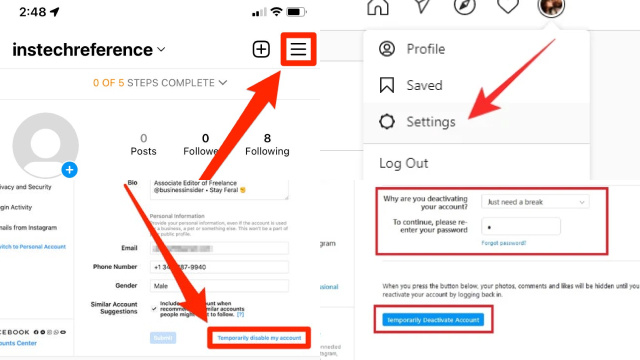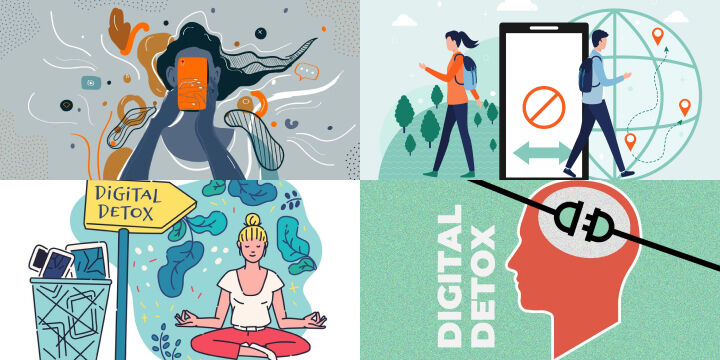Understanding the Difference Between Deactivating and Deleting Instagram
Deactivating and deleting your Instagram account are two different processes that have distinct outcomes. Deactivating your account temporarily disables your profile and removes it from public view, but your photos, comments, and likes are saved and can be restored if you choose to reactivate your account later.
On the other hand, deleting your account is a permanent action that permanently removes all of your photos, videos, comments, and likes from Instagram. Additionally, you will not be able to reactivate your account or retrieve any of your data after deleting your account.
If you want to take a break from Instagram but plan to return later, deactivating your account is a better option. However, if you no longer want to use Instagram and want to delete your data permanently, deleting your account is the way to go.
It’s important to understand the differences between the two processes before taking any action to ensure that you make the right decision for your needs.
Reasons to Deactivate or Delete Your Instagram Account
There are several reasons why you might want to deactivate or delete your Instagram account:
- To take a break: If you find yourself spending too much time on Instagram or feeling overwhelmed by social media, deactivating your account can be a good way to take a break and prioritize your mental health.
- To protect your privacy: If you are concerned about your personal information being shared or your data being collected by Instagram, deleting your account can give you peace of mind.
- To avoid negative influences: If you find yourself comparing yourself to others on Instagram or feeling negatively affected by the content you see, deactivating or deleting your account can help you avoid these negative influences.
- To free up time: If you want to focus on other aspects of your life, such as your career, hobbies, or relationships, deactivating or deleting your account can free up time and mental space.
Ultimately, the decision to deactivate or delete your Instagram account is a personal one, and it’s important to consider your own needs and priorities before taking any action.
How to Deactivate Your Instagram Account Temporarily
If you want to take a break from Instagram but plan to return later, deactivating your account temporarily is a good option. Here’s how to do it:
- Open the Instagram app on your mobile device and go to your profile.
- Tap on the three horizontal lines in the top-right corner and select “Settings.”
- Scroll down and tap on “Account.”
- Select “Temporarily disable my account” at the bottom of the screen.
- Follow the prompts and enter your password to confirm that you want to deactivate your account.
- Your account will be hidden from other users, and your profile, photos, comments, and likes will be temporarily removed.
- To reactivate your account, simply log back in with your username and password, and your account will be restored.
It’s important to note that deactivating your account does not permanently delete your data, so you can still retrieve it if you decide to reactivate your account later.
How to Reactivate Your Instagram Account After Deactivation
If you previously deactivated your Instagram account but now want to reactivate it, it’s a relatively simple process. Here’s how to do it:
- Open the Instagram app on your mobile device.
- On the login screen, enter your username and password for the deactivated account.
- Once you’ve logged in, Instagram will ask you if you want to reactivate your account.
- Tap “Yes” to confirm that you want to reactivate your account.
- Your profile, photos, comments, and likes will be restored, and your account will be visible to other users again.
It’s important to note that if you deactivated your account more than 30 days ago, your data may not be recoverable, so be sure to reactivate your account within this time frame if you want to retain your data. If you’ve forgotten your login credentials, you can use the “Forgot password?” option on the login screen to reset your password.
How to Delete Your Instagram Account Permanently
If you’re ready to say goodbye to Instagram for good, you can choose to delete your account permanently. Here’s how to do it:
- Go to the “Delete Your Account” page on Instagram’s website or through this direct link: https://www.instagram.com/accounts/remove/request/permanent/.
- Select a reason for why you’re deleting your account from the drop-down menu.
- Re-enter your password when prompted to confirm that you want to delete your account.
- Click “Permanently delete my account” to complete the process.
- Your profile, photos, comments, and likes will be permanently removed, and you won’t be able to recover them.
It’s important to note that once you delete your account, you won’t be able to sign up for a new account with the same username or add that username to another account.
Additionally, Instagram does not offer a way to reactivate deleted accounts or recover data, so make sure you’re ready to permanently delete your account before proceeding.
The Risks of Deleting Your Instagram Account
Deleting your Instagram account may seem like a simple way to protect your privacy and reduce your digital footprint, but it’s important to be aware of the risks involved. Here are some things to consider:
- You’ll lose access to all of your photos, videos, and other content stored on Instagram, as well as any followers or accounts you follow.
- If you’re using Instagram for business or marketing purposes, deleting your account could impact your online presence and customer reach.
- Your online reputation could be affected if friends, family, or potential employers search for your account and find that it no longer exists.
- If you delete your account but don’t take steps to remove your personal information from Instagram’s servers, your data may still be accessible to third parties.
Before deleting your Instagram account, consider taking steps to protect your privacy, such as removing personal information and photos, adjusting your privacy settings, and limiting the data you share online.
Tips for Protecting Your Privacy While Using Instagram
Instagram is a popular social media platform that allows users to share photos, videos, and other content with friends and followers. However, it’s important to take steps to protect your privacy while using the app. Here are some tips:
- Set your account to private to control who can see your content.
- Be mindful of what you post and avoid sharing personal information like your address or phone number.
- Use a strong and unique password for your account.
- Enable two-factor authentication to add an extra layer of security to your account.
- Adjust your notification settings to limit the amount of information Instagram sends to your device.
- Use a VPN or secure connection when accessing Instagram on public Wi-Fi networks.
- Regularly review and update your privacy settings to ensure your account is as secure as possible.
By following these tips, you can enjoy using Instagram while also protecting your personal information and privacy.
Alternative Social Media Platforms to Consider
While social media platforms like Facebook, Twitter, and Instagram are popular, there are alternative platforms available that offer unique features and a different user experience. Here are some alternative social media platforms to consider:
- TikTok – a video-sharing platform with a younger demographic that has gained immense popularity in recent years.
- LinkedIn – a professional networking platform for job seekers, recruiters, and professionals to connect and share industry-related content.
- Reddit – a discussion-based platform that covers a wide range of topics and communities, where users can post and engage in discussions.
- Mastodon – a decentralized, open-source social media platform that emphasizes privacy and user control over data.
- Discord – a communication platform primarily used by gamers to chat and connect with other players.
- Vero – a platform that emphasizes privacy and control over personal data, and allows users to share content with selected groups of people.
By exploring these alternative social media platforms, users can find a platform that aligns with their interests and priorities, while offering unique features and experiences beyond the mainstream platforms.
Going Off the Grid: A Step-by-Step Guide to Achieving Digital Detox
Going off the grid for a digital detox is a rejuvenating and mindful practice in today’s hyper-connected world. Here’s a step-by-step guide to help you achieve a successful digital detox:
- Set Clear Intentions: Begin by defining why you want to disconnect. Whether it’s to reduce stress, increase productivity, or reconnect with the real world, having a clear purpose is essential.
- Plan Ahead: Inform friends, family, and colleagues about your digital detox plans, so they understand and respect your boundaries during this time.
- Designate Digital-Free Zones: Identify specific areas where digital devices are not allowed, such as the bedroom or dining table, to promote face-to-face interactions and better sleep.
- Schedule Screen-Free Time: Allocate periods throughout the day for screen-free activities, like reading, walking, or engaging in hobbies.
- Turn Off Notifications: Disable non-essential app notifications to minimize distractions and the urge to check your devices constantly.
- Limit Social Media: If complete disconnection feels overwhelming, set specific time limits for social media usage each day.
- Embrace Analog Activities: Rediscover analog pastimes like reading physical books, writing in a journal, or indulging in arts and crafts.
- Explore Nature: Spend time outdoors, whether it’s hiking, gardening, or simply taking a leisurely stroll in the park.
- Digital Declutter: While on your detox, consider decluttering your digital life by organizing files, cleaning your inbox, and unsubscribing from newsletters.
- Practice Mindfulness: Use the detox period to meditate, practice deep breathing, or engage in mindfulness exercises to reduce stress and increase awareness.
- Journal Your Experience: Keep a journal to document your thoughts, feelings, and observations throughout the detox. This reflection can help you understand the impact of technology on your life.
- Gradual Reintegration: When your detox period ends, reintroduce digital devices gradually, focusing on using technology mindfully and purposefully.
A digital detox allows you to reset, recharge, and gain perspective on your relationship with technology. It can lead to improved well-being, better productivity, and enhanced face-to-face connections.
Remember, the key is to find a balance that works for you and allows you to maintain a healthy connection with the digital world.





